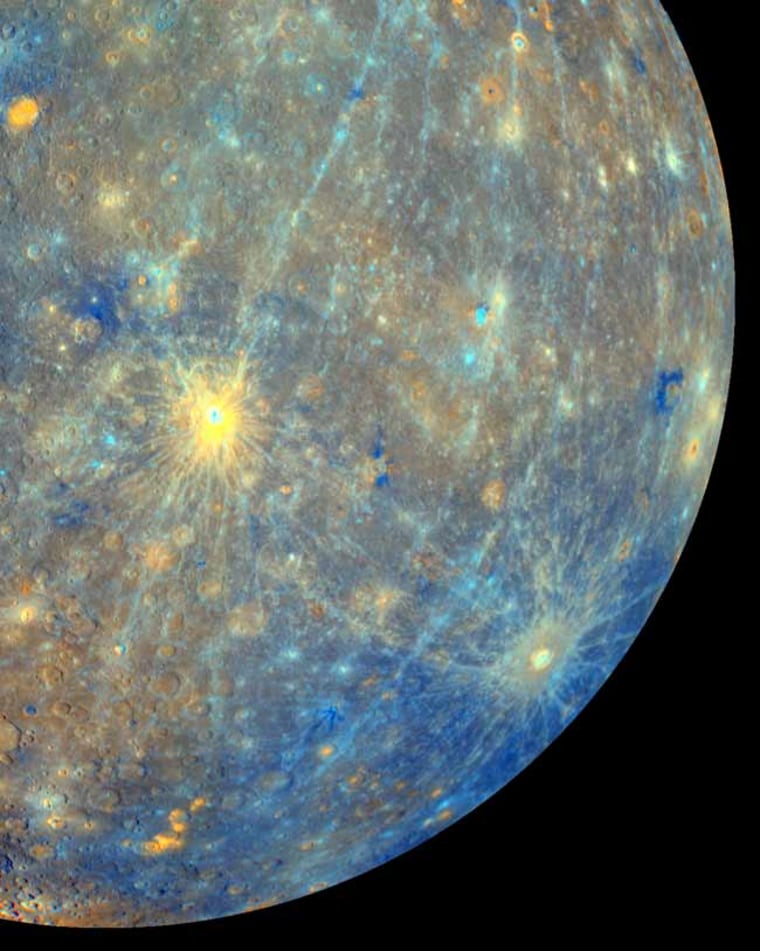New observations from NASA's MESSENGER spacecraft reveal about 30 percent of the planet Mercury that has never been seen up close before. A giant crater and evidence of ancient volcanoes are among the findings.
The photos show a giant impact crater that spans a length equivalent to the distance between Washington, D.C., and Boston.
MESSENGER (MErcury Surface, Space ENvironment, GEochemistry, and Ranging spacecraft) made its second close-approach flyby of Mercury in October 2008, after being launched in 2004. The spacecraft is the first to visit the diminutive planet since the Mariner 10 spacecraft's sojourn in the 1970s.
Until recently, scientists say the closest planet to the sun remained the least understood of the four terrestrial planets — Mercury, Venus, Earth and Mars. For a long time it was thought to be very similar to Earth's moon in composition, since both worlds have a similar gray, pockmarked appearance.
More like Mars
The new observations reveal that Mercury's crust was largely created through volcanism, with past volcanoes spitting out lava that spread and dried on the surface. In contrast, volcanism is thought to have played less of a role in forming the moon's crust.
"Volcanism was a really important process on Mercury, which is pretty exciting because before MESSENGER's flybys of Mercury we were really not even sure that volcanism existed on Mercury," said Brett Denevi, a postdoctoral researcher in the School of Earth and Space Exploration at Arizona State University. Denevi is lead author of a paper in the May 1 issue of the journal Science describing MESSENGER's new global map of Mercury.
In fact, Mercury's surface now appears to be more similar to that of Mars than of the moon.
The newly-discovered gigantic crater, called Rembrandt, stretches more than 700 kilometers (430 miles) in diameter. The bowl-like indentation in Mercury's surface was likely formed about 3.9 billion years ago by an impacting space rock. It has managed to survive with parts of its original floor still intact, without being filled in by later flows of volcanic lava, as most craters have been.
"This is the first time we have seen terrain exposed on the floor of an impact basin on Mercury that is preserved from when it formed," said Thomas Watters of the Center for Earth and Planetary Studies at the Smithsonian's National Air and Space Museum, lead author of a paper describing the crater in the same issue of Science. "Terrain like this is usually completely buried by volcanic flows."
Unique crater
The crater's floor reveals important details about Mercury's history, including multiple stages of volcanic and tectonic activity that occurred over time.
"This is really exciting because this pattern of tectonic landforms is unlike any we've seen in any other impact basin in the central solar system," Watters said.
The second MESSENGER flyby uncovered new chemicals in Mercury's tenuous atmosphere, including magnesium, which was not previously known to exist there. The discovery confirms that magnesium is an important constituent of Mercury's surface. Understanding the different elements present on Mercury helps scientists reconstruct the planet's history and its formation.
During the spacecraft's second close approach to Mercury, it also measured a much more dynamic magnetic field around the planet than was seen during the first flyby. These changes in magnetic field are tied to the powerful radiation streaming off the nearby sun, and drive variability in Mercury's atmosphere.
Researchers hope that even more secrets of Mercury will be revealed this fall, when MESSENGER makes its third and final flyby of the planet before setting into orbit around it.
